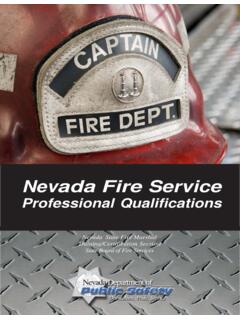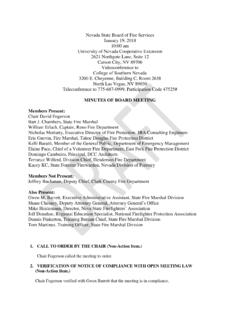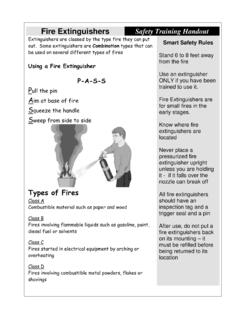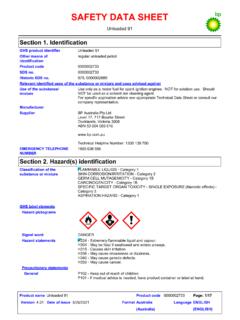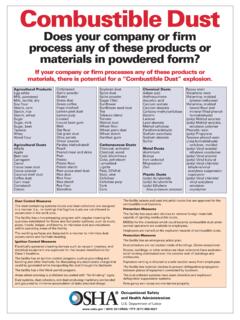Transcription of COMMON FIRE HAZARDS
1 INTRODUCTION TO FIRE INSPECTION PRINCIPLES AND PRACTICES COMMON FIRE HAZARDS TERMINAL OBJECTIVES The students will be able to: 1. Recognize the presence of fire HAZARDS in structures. 2. Recognize the presence of hazardous materials or processes. ENABLING OBJECTIVES The students will: 1. Define fire hazard. 2. Identify types of HAZARDS . 3. Recognize COMMON ignition sources. 4. Recognize and categorize hazardous materials. COMMON FIRE HAZARDS SM FH-2 COMMON FIRE HAZARDS HAZARDS A hazard is something that poses danger, peril, risk, or difficulty.
2 On the golf course a lake can be a hazard. A wet floor can be a slipping hazard. This module covers three other types of HAZARDS : COMMON fire HAZARDS , special fire HAZARDS , and hazardous materials. Part of this module covers fire HAZARDS and part hazardous materials. The term fire hazard is used by both fire professionals and the lay public. What does it mean? Any actions, materials, or conditions that might increase the size or severity of a fire or that might cause a fire to start are called fire HAZARDS . The hazard might be a fuel that is easy to ignite or a heat source like a defective appliance.
3 The hazard could be an action like thawing a pipe with a torch or an omission like failing to have a wood stove chimney cleaned. COMMON fire HAZARDS are found in most occupancies and are not associated with any special occupancy. Smoking, trash, electrical appliances, storage, and heating are COMMON to most occupancy types. However, smoke-free workplaces are making smoking a less COMMON problem. Special fire HAZARDS are linked to some specific process or activity in particular occupancies. Chemicals, spray painting, welding, combustible dusts, and flammable liquids are examples of special fire HAZARDS .
4 The first part of the module starts with ignition sources, covers the heat HAZARDS , and finishes with the fuel HAZARDS . The handling and storage of combustibles and use or misuse of ignition sources create a nearly infinite variety of hazardous conditions. The inspector is responsible for recognizing those conditions and taking proper action. IGNITION SOURCE--ELECTRICAL HAZARDS Electrical problems are a major cause of fires. Electrical service is present in almost all structures. By observing a COMMON toaster, you can see easily that there is plenty of energy available to cause a fire. However, if properly designed, installed, and maintained, electrical systems are both convenient and safe; otherwise they may be responsible for both fire and injury.
5 When an electric circuit carrying current is interrupted intentionally or unintentionally, arcing or heating is produced. Fire protection standards attempt to prevent arcing and heating, and accidental contact which may cause electric shock. SM FH-3 COMMON FIRE HAZARDS Electrical Fires Electrical fires can be divided into three categories. The first category consists of fires started by worn-out or "tired" electrical equipment. These cause the largest percentage of electrical fires. Examples include worn-out or dirty electric motors and deteriorated insulation. The second category of electrical fires is caused by improper use of approved equipment.
6 The most commonly misused electrical equipment includes electric motors, overloaded cords, and improper use of heating appliances. The third cause of electrical fires is an accidental occurrence or operator error such as clothes left in contact with lamps, items dropped into electric equipment, heating equipment left on, or defective installations. What to Look For As you inspect existing buildings, be conscious of older pieces of electrical equipment and check their cords carefully. Wiring of any sort to any piece of equipment must be replaced whenever it is worn, frayed, or cracked. You also should check how each piece of equipment is wired.
7 Ask whether it is hard wired, , connected directly to an electrical source without a plug. Is it directly plugged into an outlet? Does it have a special plug and outlet? Has a special adapter been used to connect it, such as a multiple plug adapter? Is an extension cord being used? Remember that extension cords are for temporary use only. Generally, by code, temporary wiring is permitted during construction projects, which, of course, includes remodeling. Another example of temporary wiring may be that used for audiovisual equipment within a classroom. An example of wiring that is a violation is a typewriter that is plugged into an extension cord along with a copier and a fan or heater.
8 Remember that multiple-plug adapters are generally not permitted by any of the codes. This is because it becomes too easy to overload circuits. The question often is raised as to the acceptance of heavy-duty cords with multiple plug ends that are equipped with built-in circuit breakers. The codes are silent about these so you must decide for yourself after taking the conditions of use into full consideration. SM FH-4 COMMON FIRE HAZARDS SM FH-5 Consider the overall condition of the fixed installation. Check that covers on boxes, conduits, and raceways are not corroded. Are the electric panels accessible?
9 Look for overcurrent protection that does not show signs of tampering. When inspecting equipment, look at how clean it is and, if you find dirty or dusty equipment, check the motor carefully. Motors overheat and start fires when they get dirty and ventilation is inhibited. Areas where hazardous materials are used may require very specialized electrical equipment to prevent fires and explosions. IGNITION SOURCE--HEATING Heat-producing appliances and associated equipment are also a prevalent accidental cause of fire. Heat-producing appliances normally operate at temperatures above the ignition temperature of many COMMON materials.
10 Installation, use, and maintenance of heating systems must be considered fully. Issues include proper maintenance, clearance to combustibles, fuels and fuel storage, fuel controls, proper chimneys or vents, and available air for combustion. Commercial cooking equipment must be properly installed, vented, and protected with a suppression system. Wood-burning equipment requires regular cleaning of the chimney to prevent buildup of residue that can be ignited as a flue fire. Installation and venting of solid-fuel heating equipment (wood stoves, fireplaces, inserts) are very critical. Installation must satisfy code requirements and the manufacturer's instructions.

